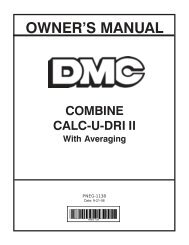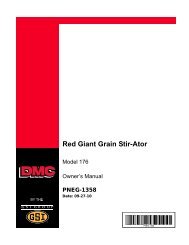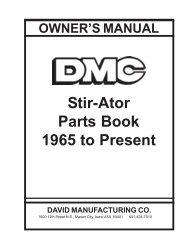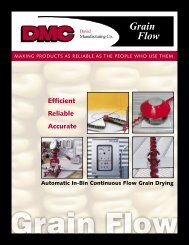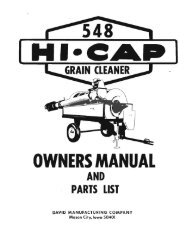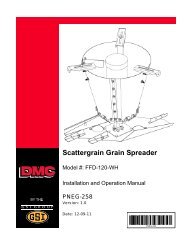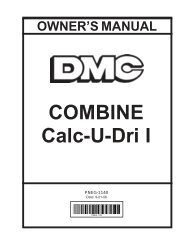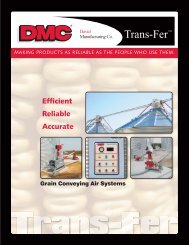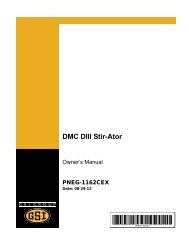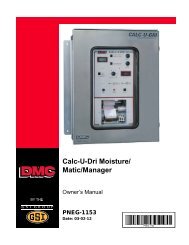PNEG-1156ETL - David Manufacturing Co.
PNEG-1156ETL - David Manufacturing Co.
PNEG-1156ETL - David Manufacturing Co.
- No tags were found...
Create successful ePaper yourself
Turn your PDF publications into a flip-book with our unique Google optimized e-Paper software.
5. OperationDrying GuideNOTE: Drying in grain depths of over 18' is not advised.The recommendations below are for drying bins without wall-liners or air tubes. If such equipment is used,higher temperatures can be used without worry of bin wall moisture. <strong>Co</strong>nsequently, a faster fill rate alsocan be utilized.Clean grain is very important to uniform drying.Grain with a moisture of 20%-26% from the field is the most profitable harvest-drying range. Grain depthsof up to 15' can be used in one fill using air only (no heat) or little heat.A moisture of 27%-30% for grain can be successfully harvested and dried, however, caution should beused. Put up to 12' of grain into the bin during the first fill. This grain should be dried down to the 20%-25%level, then additional grain can be added.When drying 27%-30% grain, it is advisable to keep the plenum (space between the floor and concretefoundation provided for air circulation for heating and ventilation of the product in the bin) temperature lessthan 50° above the ambient temperature for the first 4%-6% of moisture removed. After the initial moistureis lowered, higher temperatures can be utilized.Drying grain with 30%-35% moisture is inefficient, but sometimes necessary. If this is the case, first cleanthe grain. Then, fill the bin to a depth of 12'-15'. Dry this grain to 20%-25%. Filling up to 18' after drying the12'-15' depth will yield better results.Grain testing over 35% moisture should not be harvested for drying except under emergency conditions.Harvest damage will be extensive and drying will be very difficult and expensive. The best course to befollowed under these conditions is to fill slowly and supervise constantly.NOTE: The higher the moisture of the grain, the lower the starting temperature should be to minimize wallcondensation and ensure the highest quality of grain.Bin liners or air tubes, depending on the severity of the condition, can be used successfully to control theproblem of wet walls from condensation.DANGERAlways have the Stir-Ator turned “OFF” when taking samples.Check for moisture content of dried grain by taking and blending several samples across the top of the binand from the grain coming up near the Stir-Ator auger.<strong>PNEG</strong>-<strong>1156ETL</strong> Design III Series Grain Stir-Ator CSA 51



